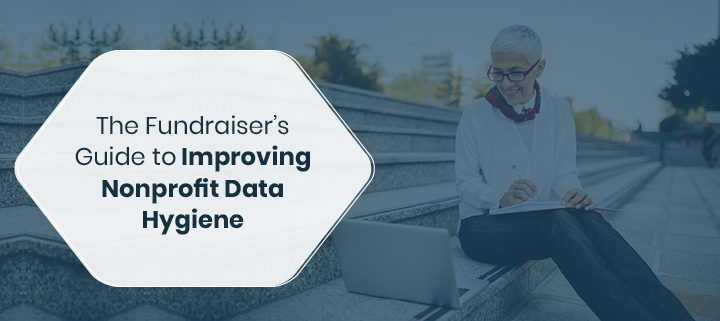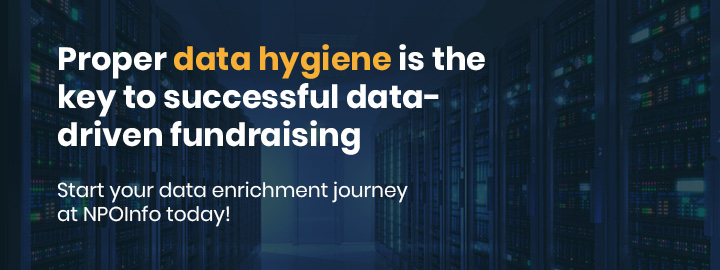The Fundraiser’s Guide to Improving Nonprofit Data Hygiene
Data is essential to the livelihood of any organization. However, it fails to hold any value if you’re unable to identify your data when you need it. Without taking the necessary steps to keep your data up-to-date, clean, clear, and concise, it is virtually useless.
So, you may be wondering, what is the key to making the most of your data? The answer is simple: proper data hygiene.
At NPOInfo, we help nonprofits elevate their internal data through database appends. By doing so, we’ve seen firsthand the importance of clean data when it comes to improving a nonprofit’s donor stewardship and fundraising efforts. Because of that, we’ve created this comprehensive guide to nonprofit data hygiene. We’ll cover the following points:
If you’re looking to optimize your fundraising efforts through using clean data, read along as we uncover all you need to know!
What is database hygiene? An Overview
Database hygiene is the ongoing procedures and processes involved with keeping a nonprofit’s main database, its constituent relationship management (CRM) system, “clean” or with few errors. These processes involve a variety of actions, such as verifying existing data, removing duplicate and non-useful records, and appending new data to fill gaps in any incomplete records.
This is crucial, as “dirty” data can lead to many fatal pitfalls, including ineffective lead tracking, marketing missteps, and the inability to personalize outreach materials to donors and subscribers.
Most commonly, we see database hygiene discussed in relation to the following information:
- Postal addresses: On average, 15% of individuals move each year, but 35% of those people fail to update their address information. Failing to keep track of postal addresses will put your information in the wrong hands— something you definitely don’t want to happen!
- Email addresses: Email marketing has the highest return on investment of any channel, with $40 gained for every $1 spent. Therefore, you want to be certain your nonprofit is receiving email addresses from contacts and keeping this data clean. Approximately 54% of records in a nonprofit’s database are missing email addresses.
- Phone numbers: Research indicates that 42% of records are missing phone information; an issue that needs rapid resolving.
- Deceased: As a means of preserving resources and reducing perceived insensitivity, it is important to conduct routine deceased suppression as part of your data hygiene routine.
- Duplicates: For organizations with multiple databases, it is extremely common to find duplicate information.
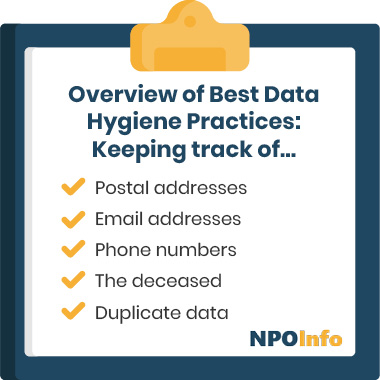
These aspects provide a simple overview of the key components nonprofit organizations must pay attention to when evaluating the hygiene of their data. However, it is just as important to understand the value that this data presents to nonprofits in the first place.
Why does clean data matter for nonprofits?
Nonprofit data hygiene is a key factor in achieving data maturity. Research shows that every day, 2.5 quintillion bytes of data are generated globally. However, most of this data remains underutilized by nonprofits due to a lack of data organization.
For your nonprofit, this could mean:
- Missing out on opportunities to engage supporters. One of the best places to start the process of major gift prospecting is in your donor database, but disorganized data can obscure a strong prospect’s capacity and affinity markers. Additionally, you might miss an opportunity to invite a supporter to a fundraising event or volunteer opportunity they would be interested in if their engagement history is unclear.
- Overspending on outreach. Messy, disorganized data could lead to wasting resources by sending costly direct mail solicitations to outdated addresses. Or, you might end up spending more on communication channels that supporters don’t use or respond to than on the ones they regularly engage with.
- Lapsed donors. Not carefully tracking supporters’ involvement can lead to missed follow-ups, which can come off as a lack of appreciation for their contributions. When donors don’t feel like your organization values their support, they’re more likely to stop engaging.
When your nonprofit’s data is disorganized, valuable information goes by the wayside. Be sure to take advantage of all potential opportunities by maintaining clean data.
How do nonprofits use data?
On the flip side, maintaining proper data hygiene can benefit your nonprofit in numerous ways. As the world transitions into a more digital lifestyle, the volume of available data continues to grow. Nonprofits are striving to be more data-driven in response, and it’s no secret that data-driven strategies tend to be the most effective.
There are six main types of data your nonprofit should collect, each of which provides a unique benefit:

- Donor data, which helps your nonprofit better understand its individual supporters and develop stronger relationships with them.
- Campaign data, which provides insight into your nonprofit’s fundraising strengths and potential areas for improvement.
- Marketing data, which allows you to identify the best ways to reach supporters and amplify your mission.
- Financial data, which helps you assess your revenue and expenses to aid in developing a stronger financial management system.
- Website data, which allows you to develop stronger content and provide a better user experience within the main digital hub of information about and engagement with your organization.
- External data, which is useful in planning for organizational growth as it provides new perspectives on your mission and industry.
While most nonprofits rely on data when planning their fundraising, outreach, and stewardship efforts, this is significantly easier and more likely to succeed when your data is hygienic.
5 Common Nonprofit Data Hygiene Challenges
While working to clean up your data, you may encounter several challenges that make it difficult for you to organize the information at hand. Here are common data hygiene challenges that your nonprofit may encounter, as well as steps to resolve them.

Ambiguous Data
Ambiguous data is information that is too broad to decipher its true meaning. More simply, it is when the same code is used for two different types of data. For example, if you use the label “board” to indicate someone’s ranking, you may forget later down the road if that individual is a current or former board member. This difference in title is important to take into consideration before approaching the individual for future campaigns. You probably don’t want to seek the aid of a former board member, though you would with a current board member!
To fix this issue, identify how each type of data should be coded moving forward. In the example above, you can establish clarity through coding current members as “current board” and former members as “former board.” Specificity is key. When cleaning data, review all records with ambiguous coding and update them as you go.
Duplicate Data
Duplicate data is identical data entered throughout your database. This most commonly happens in the form of having two records for one supporter— for example, if an individual made two gifts, each on a different date and each from different email addresses. Your CRM could record this as though there are two separate supporters, rather than one individual with two email addresses. It’s important to rid your system of duplicate data to avoid redundancy in your approach (such as that one donor receiving double the communications).
Implement a deduplication process at least once per quarter to stay on top of the game. Additionally, your database should have a merge tool that you can use to review duplicate records side by side and decide which records to merge into one and which to keep separate.
Inconsistent Data
Inconsistent data is when your entries differ across multiple databases. For example, if one of your systems says that two individuals are married while the other says they are divorced, sending them joint communication efforts may be a mistake. You can avoid issues like this through keeping your data consistent.
If you suspect that some of your data is incorrect, identify a threshold for data you will review. For instance, when considering donors, it may be wise to establish a review for those who have gifted a certain amount or higher. Hypothetically, if someone donated $3 million to your organization, your system should flag this entry and notify staff to double check that this amount is correct before proceeding. Implementations such as this will help prevent inconsistent data down the road.
Misplaced Data
Sometimes data is simply misplaced in the system. With such high variability in human error, this is very common in free-text fields. For example, you could have John Smith’s email address entered under Mary Jones. Making sure everything is in the right place will make your marketing and fundraising efforts run as smoothly as possible.
As with all other challenges, a thorough review of data entries will help to identify if data has been entered in the wrong location. Be sure to review misplaced data as needed, move the data into its correct location, and delete the data from its original, incorrect location.
Missing Data
Missing data is a cause for concern, as it is impossible for your organization to use such valuable information if it isn’t there in the first place. A common example of this is missing contact information, such as email address or phone number, resulting from “optional” form entry fields. If you’ve ever made an online donation to a nonprofit and left one of the two “contact information” fields blank, you’re a source of missing data for that organization!
If you have other data sources that contain what you need—such as old databases or third-party systems—you may seek these for filling in the blanks of missing information. Not to mention, the data append services provided by NPOInfo make the processes of finding missing data quite simple. From email addresses to phone numbers, our data append services can locate exactly what you need.
How do you clean donor data? 5 Steps
Now that you know what clean data is, the importance of maintaining it, and the challenges you may encounter along the way, it is time to dive into the nitty-gritty of exactly how to clean your data. Here are the five data hygiene steps we will discuss:
- Conduct an audit of your nonprofit database.
- Remove unnecessary or harmful information.
- Take a closer look at the data you have left.
- Standardize processes for ongoing maintenance.
- Bring an expert on board to help.
Let’s begin!
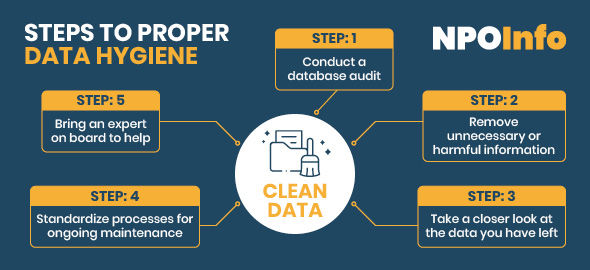
Step 1: Conduct a database audit.
Conducting a database audit is the first step in cleaning your donor data. An audit allows you to assess the current state of your data and discover the areas most in need of improvement.
Use the following steps to conduct your database audit:
Step 1: Identify problems you’re facing regarding data collection. What are the main issues your organization is facing that impede on proper data collection? What are you looking to get out of the audit process?
Step 2: Pinpoint unhelpful information. Identify which pieces of your information are inaccurate, outdated, or utterly incorrect. Make note of these points and you will help yourself in the long run. Keeping this information within your database will prove more harmful than helpful.
Step 3: Identify inconsistencies in your data. If you are a long-standing organization, your team has probably gone through several different data input procedures. As a result, you have probably cycled through many different ways of uploading names, addresses, dates, and other types of information. If you are a newer nonprofit, the threat of human error can also lead to variability amongst data input. Use your audit to note any inconsistencies that have occurred.
Step 4: Share your findings with your team. Once the audit is complete, be sure to share the information discovered with all parties involved. Ensure stakeholders—such as board members and executive leadership—are aware of the findings and on board with moving to the next steps of the data hygiene process
By conducting a database audit, you can produce an official review of your database to understand what areas contain the largest amount of inaccuracies, what information is missing, and where gaps in your data lie. This will put you in the best position for correcting your data moving forward.
Step 2: Remove unnecessary or harmful information.
Once you have conducted your audit, it’s time to get rid of any extraneous content. These pieces of irrelevant information will ultimately be a waste of time and money, as you’ll end up sending marketing materials and messages to those who don’t want to or are not able to engage with your information. Some examples of unusable data points to remove include:
- People on Do Not Call lists: Individuals who wish to opt-out of telemarketing calls register with the National Do Not Call Registry. Nonprofits are traditionally exempt from these regulations, but if your organization partners with a commercial telemarketing company you must comply with these guidelines.
- Do Not Mail lists: People who wish to not receive mail and emails from businesses can register with the Direct Marketing Association (DMA) website, DMAchoice. Nonprofits are not required to use this list either.
- Minors: Remove those under the age of 18 from your database. This is especially crucial as if you conduct marketing to children, you can be fined by the Federal Trade Commission (FTC).
- Incarcerated individuals: Those who are currently within the prison system cannot respond to marketing materials. Remove individuals within federal and state prisons, county correctional facilities, and jails as a means of preserving your resources.
- Deceased persons: By making sure not to contact the deceased, you can prevent sending unwanted marketing materials to their family members. Failing to do so often comes off as insensitive.
Once this information has been eliminated, you’re left with a database that contains information only about those who are interested in hearing from you and are able to respond to your messages. Remember, more data in your database isn’t necessarily better. If you need help determining what data to keep or not to keep, nonprofit data hygiene providers can assist you with removing these types of records or suppressing them from your direct marketing efforts.
Step 3: Take a closer look at the data you have left.
After refining your database and removing unwanted information, assess your remaining data closely. In particular, it is important to assess and correct the database errors you identified during the primary audit stage. You can ensure your records are clean by:
- Eliminating duplicate entries: Verify the correct entry and merge or eliminate any copies that might have emerged over the years.
- Standardizing mailing addresses: When inputting mailing address information, establish a standardized method for interchangeable abbreviations, such as “Lane” or “Ln.” Also, be sure to establish guidelines when it comes to area codes: 5-digit ZIP code versus ZIP+4 code.
- Verifying email addresses: Ensure all remaining addresses are real and active. Following this principle will increase your email engagement rate and allows you to save time and resources by only sending messages to correct, active email addresses.
- Ensuring numbers and abbreviations are standardized: This includes titles, ages, and any code words your team uses to categorize donors or prospects.
Taking the time to refine data will help correct small inconsistencies that can add up to much larger issues.
Step 4: Standardize processes for ongoing maintenance
It is best to adopt continuous data hygiene practices, rather than conduct an occasional major—and very time-consuming—cleanse. Ensure future success by creating an ongoing process for standardized data entry and maintenance. Some important tactics to consider implementing would be:
- Standardizing data input practices. Outline the rules for team members to follow when they input new information into your nonprofit database. This includes procedures for inputting names, phone numbers, physical email addresses, employment information, and all other relevant data points.
- Creating a data training process for staff. Create a shared document that includes all the details team members need to use the database effectively. Review the process in a meeting or training seminar so that everyone is on the same page for protocol.
- Defining rules for handling errors. Define the process of correcting errors and include it within your data input process documentation. Who is responsible for fixing incorrect, incomplete, or duplicate records in your system?
- Streamlining your donor-facing forms to only ask for essential information. This refers to elements that request information from the donor, such as your newsletter sign-up page or online donation form. Streamlining these platforms will help prevent the buildup of unnecessary or harmful data that inevitably clogs your database.
Using these practices as a means of standardizing your data maintenance approach will help make the process manageable. The maintenance process is customizable to your organization, so be sure to implement whatever tools work best for you!
Step 5: Bring an expert on board to help
Establishing good data hygiene can be challenging, especially when you’re not sure where to start. Professionals that specialize in nonprofit data hygiene can set your team up with a concrete plan for future success in data management practices.
Database marketing specialists can assist with all of the processes outlined in the steps above, but they don’t stop there. These professionals provide a wide array of other services, such as:
- Merge and Purge: Identifying and combining or eliminating duplicate records in your database.
- File Conversions: Converting files into useful formats according to the various needs of your organization.
- A/B Splits: Segmenting your data into groups to determine which marketing strategies are most effective.
- Parsing: Splitting up the elements of one record into separate fields in your database.
Data appends. Supplementing data from your organization’s internal database with external information. Learn more about how NPOInfo can help you do this!
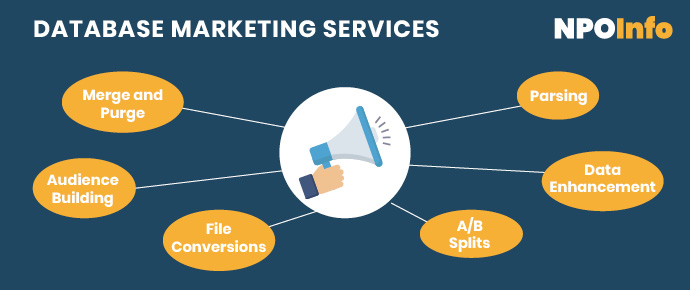
Beyond hygiene, data marketing firms also conduct data enhancement, audience building, targeted digital marketing, and other marketing efforts. Partnering with professionals containing these valuable skills will leave your organization with a stronger framework for future campaigns.
3 Donor Database Best Practices to Improve Your Data Hygiene
Create processes for standardizing data formatting.
To make sure all relevant donor data appears in reports and is properly formatted, establish standards. For processes that are unique to your organization, you’ll need to formulate your own internal standards.
You will want to have rules in place for information such as:
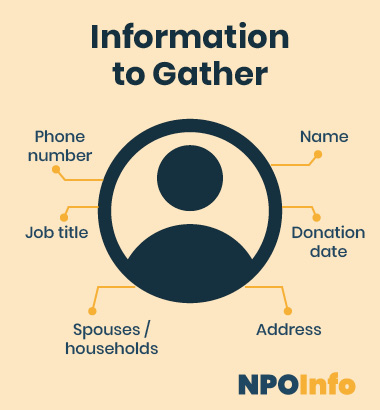
- Names: Decide how you will deal with formal first names versus nicknames or preferred names. Designate a field for each and use them consistently. Set rules for capitalization and abbreviation, but avoid writing names as fully capitalized.
- Addresses: Determine whether you spell out or abbreviate a roadway, such as writing “Street” or “St.” Set rules for entering apartment numbers. For example, if you are referring to someone living in Apartment 10, would you reference it #10, Apt. 10, or Unit 10? Decide whether or not to abbreviate the names of states, like CA vs California.
- Donation Dates: Should the donation date entered be the date on the check or the deposit date?
- Spouses and households: Define a process for associating contacts who live in the same household. By grouping individuals with the same address, you can avoid redundancy in your messaging.
- Job titles: Decide to spell out or appreciate job titles. Create a list of standard titles—such as Doctor or Dr.—and how they should be shortened if you plan to use abbreviations.
- Phone numbers: Standardize the entry of phone numbers using. You might use parenthesis ( (555) 555-555), dashes (555-555-555) or no punctuation (555555555).
When it is all said and done, as long as the information is held to the same standards, you should have no need to worry. Be sure to collect the same information for all of the contacts in your database and whenever possible, include as much information as you can.
Schedule regular data back-ups.
An important, and often forgotten, component of data collection is regularly backing it up. In a survey by Jay Love, 60% of organizations admitted to not backing up their data properly each day. Further, only 5% claimed to even test their backup solutions–a recipe for disaster!
In case of a software crash, the last thing you want to happen is a loss of all of your data. To prevent this from occurring, it is essential that your organization undergoes proper back-up procedures each day to ensure your data remains safe.
Equally important to backing up your data is testing your data. By this we mean, your organization should run tests to make sure the data saved in your backup is recoverable and usable.
Invest in data appends
To enhance your clean data, it would be in the best interest of your nonprofit to invest in data appends. By doing so, you will house the most organized and up-to-date information within your database.
NPOInfo offers a wide array of services that can assist the data append process. Such services include:
- Employer Appends: Knowing where your donors work is incredibly important. Here at NPOInfo, we use our proprietary screening and identification methods to append employer information, and oftentimes a job role, to individual records. Our screening method gathers data from both public and private sources, giving you the most accurate information possible.
- Email Appends: Emails are crucial to reaching your donors and not to mention, the most cost-efficient for your organization. Therefore, it is important you have the right email addresses listed within your database. NPOInfo can help you fill in any of those gaps.
- Phone Number Appends: Whether you’re looking to contact a donor or constituent, having the correct phone number is necessary. The NPOInfo phone number append service provides you with both cellphone and landline numbers to be used for both your regular donation solicitations, as well as matching gift reminders.
- Date of Birth Appends: Being aware of your supporters’ ages and dates of birth is important to your organization’s marketing efforts. Whether it be for birthday mailing or market segmentation, our services will help you to best pinpoint birthdates for all of your needs.
- Address Appends: With more than 40 million Americans moving each year, having up-to-date address information will save your organization significant funding that can be lost due to misinformation. Double the Donation offers National Change of Address screenings to ensure your organization has up-to-date mailing addresses. Further, NPOInfo provides standardized addresses that meet the USPS’s requirements for bulk mailing rates.
Data appends provide irreplaceable value to your organization’s marketing and fundraising efforts, so consider the help of NPOInfo in your next data append pursuit!
If you are interested in learning more about the importance of proper nonprofit data hygiene, here are some additional resources to explore:
- Matching Gift Databases: Our Comprehensive Guide for 2021. If you’re interested in learning how data hygiene can elevate your fundraising through matching gift databases, read this article to learn more!
- Improving The Donor Journey With Matching Gifts. Learn how to best optimize your relationships with donors to make the most of your fundraising experience in this article.
- Corporate Giving Programs: The Ultimate Fundraising Guide. Corporate giving programs are a great way to boost the flow of incoming funds to your nonprofit. If you’re interested in this, find out more here!

